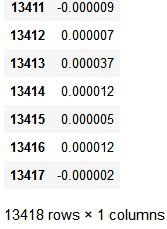一、请知晓
本文是基于:
Event Recommendation Engine Challenge分步解析第一步
Event Recommendation Engine Challenge分步解析第二步
Event Recommendation Engine Challenge分步解析第三步
Event Recommendation Engine Challenge分步解析第四步
需要读者先阅读前四篇文章解析
二、活跃度/event热度数据
由于用到event_attendees.csv.gz文件,我们先看看该文件
import pandas as pd
df_events_attendees = pd.read_csv('event_attendees.csv.gz', compression='gzip')
df_events_attendees.head()
代码示例结果(该文件保存了某event出席情况信息):

1)变量解释
nevents:train.csv和test.csv中总共的events数目,这里值为13418
self.eventPopularity:稀疏矩阵,shape为(nevents,1),保存的值是某个event在上图中yes数目-no数目,即一行行处理上述文件,获取该event的index,后yes列空格分割后数目减去no列空格分割数目,并做归一化
import pandas as pd
import scipy.io as sio
eventPopularity = sio.mmread('EA_eventPopularity').todense()
pd.DataFrame(eventPopularity)代码示例结果:


第五步完整代码:
from collections import defaultdict
import locale, pycountry
import scipy.sparse as ss
import scipy.io as sio
import itertools
#import cPickle
#From python3, cPickle has beed replaced by _pickle
import _pickle as cPickleimport scipy.spatial.distance as ssd
import datetime
from sklearn.preprocessing import normalizeimport gzip
import numpy as npimport hashlib#处理user和event关联数据
class ProgramEntities:"""我们只关心train和test中出现的user和event,因此重点处理这部分关联数据,经过统计:train和test中总共3391个users和13418个events"""def __init__(self):#统计训练集中有多少独立的用户的eventsuniqueUsers = set()#uniqueUsers保存总共多少个用户:3391个uniqueEvents = set()#uniqueEvents保存总共多少个events:13418个eventsForUser = defaultdict(set)#字典eventsForUser保存了每个user:所对应的eventusersForEvent = defaultdict(set)#字典usersForEvent保存了每个event:哪些user点击for filename in ['train.csv', 'test.csv']:f = open(filename)f.readline()#跳过第一行for line in f:cols = line.strip().split(',')uniqueUsers.add( cols[0] )uniqueEvents.add( cols[1] )eventsForUser[cols[0]].add( cols[1] )usersForEvent[cols[1]].add( cols[0] )f.close()self.userEventScores = ss.dok_matrix( ( len(uniqueUsers), len(uniqueEvents) ) )self.userIndex = dict()self.eventIndex = dict()for i, u in enumerate(uniqueUsers):self.userIndex[u] = ifor i, e in enumerate(uniqueEvents):self.eventIndex[e] = iftrain = open('train.csv')ftrain.readline()for line in ftrain:cols = line.strip().split(',')i = self.userIndex[ cols[0] ]j = self.eventIndex[ cols[1] ]self.userEventScores[i, j] = int( cols[4] ) - int( cols[5] )ftrain.close()sio.mmwrite('PE_userEventScores', self.userEventScores)#为了防止不必要的计算,我们找出来所有关联的用户或者关联的event#所谓关联用户指的是至少在同一个event上有行为的用户user pair#关联的event指的是至少同一个user有行为的event pairself.uniqueUserPairs = set()self.uniqueEventPairs = set()for event in uniqueEvents:users = usersForEvent[event]if len(users) > 2:self.uniqueUserPairs.update( itertools.combinations(users, 2) )for user in uniqueUsers:events = eventsForUser[user]if len(events) > 2:self.uniqueEventPairs.update( itertools.combinations(events, 2) )#rint(self.userIndex)cPickle.dump( self.userIndex, open('PE_userIndex.pkl', 'wb'))cPickle.dump( self.eventIndex, open('PE_eventIndex.pkl', 'wb') )#数据清洗类
class DataCleaner:def __init__(self):#一些字符串转数值的方法#载入localeself.localeIdMap = defaultdict(int)for i, l in enumerate(locale.locale_alias.keys()):self.localeIdMap[l] = i + 1#载入countryself.countryIdMap = defaultdict(int)ctryIdx = defaultdict(int)for i, c in enumerate(pycountry.countries):self.countryIdMap[c.name.lower()] = i + 1if c.name.lower() == 'usa':ctryIdx['US'] = iif c.name.lower() == 'canada':ctryIdx['CA'] = ifor cc in ctryIdx.keys():for s in pycountry.subdivisions.get(country_code=cc):self.countryIdMap[s.name.lower()] = ctryIdx[cc] + 1self.genderIdMap = defaultdict(int, {'male':1, 'female':2})#处理LocaleIddef getLocaleId(self, locstr):#这样因为localeIdMap是defaultdict(int),如果key中没有locstr.lower(),就会返回默认int 0return self.localeIdMap[ locstr.lower() ]#处理birthyeardef getBirthYearInt(self, birthYear):try:return 0 if birthYear == 'None' else int(birthYear)except:return 0#性别处理def getGenderId(self, genderStr):return self.genderIdMap[genderStr]#joinedAtdef getJoinedYearMonth(self, dateString):dttm = datetime.datetime.strptime(dateString, "%Y-%m-%dT%H:%M:%S.%fZ")return "".join( [str(dttm.year), str(dttm.month) ] )#处理locationdef getCountryId(self, location):if (isinstance( location, str)) and len(location.strip()) > 0 and location.rfind(' ') > -1:return self.countryIdMap[ location[location.rindex(' ') + 2: ].lower() ]else:return 0#处理timezonedef getTimezoneInt(self, timezone):try:return int(timezone)except:return 0def getFeatureHash(self, value):if len(value.strip()) == 0:return -1else:#return int( hashlib.sha224(value).hexdigest()[0:4], 16) python3会报如下错误#TypeError: Unicode-objects must be encoded before hashingreturn int( hashlib.sha224(value.encode('utf-8')).hexdigest()[0:4], 16)#python必须先进行encodedef getFloatValue(self, value):if len(value.strip()) == 0:return 0.0else:return float(value)#用户与用户相似度矩阵
class Users:"""构建user/user相似度矩阵"""def __init__(self, programEntities, sim=ssd.correlation):#spatial.distance.correlation(u, v) #计算向量u和v之间的相关系数cleaner = DataCleaner()nusers = len(programEntities.userIndex.keys())#3391#print(nusers)fin = open('users.csv')colnames = fin.readline().strip().split(',') #7列特征self.userMatrix = ss.dok_matrix( (nusers, len(colnames)-1 ) )#构建稀疏矩阵for line in fin:cols = line.strip().split(',')#只考虑train.csv中出现的用户,这一行是作者注释上的,但是我不是很理解#userIndex包含了train和test的所有用户,为何说只考虑train.csv中出现的用户if cols[0] in programEntities.userIndex:i = programEntities.userIndex[ cols[0] ]#获取user:对应的indexself.userMatrix[i, 0] = cleaner.getLocaleId( cols[1] )#localeself.userMatrix[i, 1] = cleaner.getBirthYearInt( cols[2] )#birthyear,空值0填充self.userMatrix[i, 2] = cleaner.getGenderId( cols[3] )#处理性别self.userMatrix[i, 3] = cleaner.getJoinedYearMonth( cols[4] )#处理joinedAt列self.userMatrix[i, 4] = cleaner.getCountryId( cols[5] )#处理locationself.userMatrix[i, 5] = cleaner.getTimezoneInt( cols[6] )#处理timezonefin.close()#归一化矩阵self.userMatrix = normalize(self.userMatrix, norm='l1', axis=0, copy=False)sio.mmwrite('US_userMatrix', self.userMatrix)#计算用户相似度矩阵,之后会用到self.userSimMatrix = ss.dok_matrix( (nusers, nusers) )#(3391,3391)for i in range(0, nusers):self.userSimMatrix[i, i] = 1.0for u1, u2 in programEntities.uniqueUserPairs:i = programEntities.userIndex[u1]j = programEntities.userIndex[u2]if (i, j) not in self.userSimMatrix:#print(self.userMatrix.getrow(i).todense()) 如[[0.00028123,0.00029847,0.00043592,0.00035208,0,0.00032346]]#print(self.userMatrix.getrow(j).todense()) 如[[0.00028123,0.00029742,0.00043592,0.00035208,0,-0.00032346]]usim = sim(self.userMatrix.getrow(i).todense(),self.userMatrix.getrow(j).todense())self.userSimMatrix[i, j] = usimself.userSimMatrix[j, i] = usimsio.mmwrite('US_userSimMatrix', self.userSimMatrix)#用户社交关系挖掘
class UserFriends:"""找出某用户的那些朋友,想法非常简单1)如果你有更多的朋友,可能你性格外向,更容易参加各种活动2)如果你朋友会参加某个活动,可能你也会跟随去参加一下"""def __init__(self, programEntities):nusers = len(programEntities.userIndex.keys())#3391self.numFriends = np.zeros( (nusers) )#array([0., 0., 0., ..., 0., 0., 0.]),保存每一个用户的朋友数self.userFriends = ss.dok_matrix( (nusers, nusers) )fin = gzip.open('user_friends.csv.gz')print( 'Header In User_friends.csv.gz:',fin.readline() )ln = 0#逐行打开user_friends.csv.gz文件#判断第一列的user是否在userIndex中,只有user在userIndex中才是我们关心的user#获取该用户的Index,和朋友数目#对于该用户的每一个朋友,如果朋友也在userIndex中,获取其朋友的userIndex,然后去userEventScores中获取该朋友对每个events的反应#score即为该朋友对所有events的平均分#userFriends矩阵记录了用户和朋友之间的score#如851286067:1750用户出现在test.csv中,该用户在User_friends.csv.gz中一共2151个朋友#那么其朋友占比应该是2151 / 总的朋友数sumNumFriends=3731377.0 = 2151 / 3731377 = 0.0005764627910822198for line in fin:if ln % 200 == 0:print( 'Loading line:', ln )cols = line.decode().strip().split(',')user = cols[0]if user in programEntities.userIndex:friends = cols[1].split(' ')#获得该用户的朋友列表i = programEntities.userIndex[user]self.numFriends[i] = len(friends)for friend in friends:if friend in programEntities.userIndex:j = programEntities.userIndex[friend]#the objective of this score is to infer the degree to#and direction in which this friend will influence the#user's decision, so we sum the user/event score for#this user across all training eventseventsForUser = programEntities.userEventScores.getrow(j).todense()#获取朋友对每个events的反应:0, 1, or -1#print(eventsForUser.sum(), np.shape(eventsForUser)[1] )#socre即是用户朋友在13418个events上的平均分score = eventsForUser.sum() / np.shape(eventsForUser)[1]#eventsForUser = 13418,#print(score)self.userFriends[i, j] += scoreself.userFriends[j, i] += scoreln += 1fin.close()#归一化数组sumNumFriends = self.numFriends.sum(axis=0)#每个用户的朋友数相加#print(sumNumFriends)self.numFriends = self.numFriends / sumNumFriends#每个user的朋友数目比例sio.mmwrite('UF_numFriends', np.matrix(self.numFriends) )self.userFriends = normalize(self.userFriends, norm='l1', axis=0, copy=False)sio.mmwrite('UF_userFriends', self.userFriends)#构造event和event相似度数据
class Events:"""构建event-event相似度,注意这里有2种相似度1)由用户-event行为,类似协同过滤算出的相似度2)由event本身的内容(event信息)计算出的event-event相似度"""def __init__(self, programEntities, psim=ssd.correlation, csim=ssd.cosine):cleaner = DataCleaner()fin = gzip.open('events.csv.gz')fin.readline()#skip headernevents = len(programEntities.eventIndex)print(nevents)#13418self.eventPropMatrix = ss.dok_matrix( (nevents, 7) )self.eventContMatrix = ss.dok_matrix( (nevents, 100) )ln = 0for line in fin:#if ln > 10:#breakcols = line.decode().strip().split(',')eventId = cols[0]if eventId in programEntities.eventIndex:i = programEntities.eventIndex[eventId]self.eventPropMatrix[i, 0] = cleaner.getJoinedYearMonth( cols[2] )#start_timeself.eventPropMatrix[i, 1] = cleaner.getFeatureHash( cols[3] )#cityself.eventPropMatrix[i, 2] = cleaner.getFeatureHash( cols[4] )#stateself.eventPropMatrix[i, 3] = cleaner.getFeatureHash( cols[5] )#zipself.eventPropMatrix[i, 4] = cleaner.getFeatureHash( cols[6] )#countryself.eventPropMatrix[i, 5] = cleaner.getFloatValue( cols[7] )#latself.eventPropMatrix[i, 6] = cleaner.getFloatValue( cols[8] )#lonfor j in range(9, 109):self.eventContMatrix[i, j-9] = cols[j]ln += 1fin.close()self.eventPropMatrix = normalize(self.eventPropMatrix, norm='l1', axis=0, copy=False)sio.mmwrite('EV_eventPropMatrix', self.eventPropMatrix)self.eventContMatrix = normalize(self.eventContMatrix, norm='l1', axis=0, copy=False)sio.mmwrite('EV_eventContMatrix', self.eventContMatrix)#calculate similarity between event pairs based on the two matricesself.eventPropSim = ss.dok_matrix( (nevents, nevents) )self.eventContSim = ss.dok_matrix( (nevents, nevents) )for e1, e2 in programEntities.uniqueEventPairs:i = programEntities.eventIndex[e1]j = programEntities.eventIndex[e2]if not ((i, j) in self.eventPropSim):epsim = psim( self.eventPropMatrix.getrow(i).todense(), self.eventPropMatrix.getrow(j).todense())if np.isnan(epsim):epsim = 0self.eventPropSim[i, j] = epsimself.eventPropSim[j, i] = epsimif not ((i, j) in self.eventContSim):#两个向量,如果某个全为0,会返回nan"""import numpy as npa = np.array([0, 1, 1, 1, 0, 0, 0, 1, 0, 0])b = np.array([0, 0, 0, 0, 0, 0, 0, 0, 0, 0])from scipy.spatial.distance import cosinetemp = cosine(a, b)会出现下面问题:Warning (from warnings module):File "D:\Python35\lib\site-packages\scipy\spatial\distance.py", line 644dist = 1.0 - uv / np.sqrt(uu * vv)RuntimeWarning: invalid value encountered in double_scalars"""ecsim = csim( self.eventContMatrix.getrow(i).todense(), self.eventContMatrix.getrow(j).todense())if np.isnan(ecsim):ecsim = 0self.eventContSim[i, j] = ecsimself.eventContSim[j, i] = ecsimsio.mmwrite('EV_eventPropSim', self.eventPropSim)sio.mmwrite('EV_eventContSim', self.eventContSim)class EventAttendees:"""统计某个活动,参加和不参加的人数,从而为活动活跃度做准备"""def __init__(self, programEntities):nevents = len(programEntities.eventIndex)#13418self.eventPopularity = ss.dok_matrix( (nevents, 1) )f = gzip.open('event_attendees.csv.gz')f.readline()#skip headerfor line in f:cols = line.decode().strip().split(',')eventId = cols[0]if eventId in programEntities.eventIndex:i = programEntities.eventIndex[eventId]self.eventPopularity[i, 0] = len(cols[1].split(' ')) - len(cols[4].split(' '))#yes人数-no人数,即出席人数减未出席人数f.close()self.eventPopularity = normalize( self.eventPopularity, norm='l1', axis=0, copy=False)sio.mmwrite('EA_eventPopularity', self.eventPopularity)def data_prepare():"""计算生成所有的数据,用矩阵或者其他形式存储方便后续提取特征和建模"""print('第1步:统计user和event相关信息...')pe = ProgramEntities()print('第1步完成...\n')print('第2步:计算用户相似度信息,并用矩阵形式存储...')Users(pe)print('第2步完成...\n')print('第3步:计算用户社交关系信息,并存储...')UserFriends(pe)print('第3步完成...\n')print('第4步:计算event相似度信息,并用矩阵形式存储...')Events(pe)print('第4步完成...\n')print('第5步:计算event热度信息...')EventAttendees(pe)print('第5步完成...\n')#运行进行数据准备
data_prepare()
综上完成数据的预处理和保存功能
下面我们来看看特征构建:Event Recommendation Engine Challenge分步解析第六步




)


...)











